[p. III] A Pioneer In Pali Lexicography
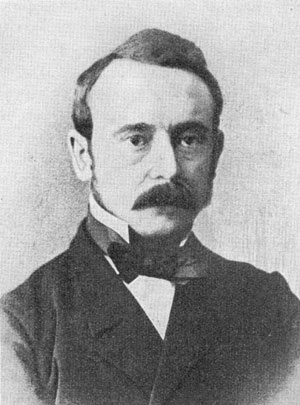
V. Trenckner. * 26. Febr. 1824 — † 9. Jan. 1891.
The year 1855 is the most memorable year in the history of Pāli-Studies in Denmark, being marked by Fausbøll's Edition of the Dhammapada, the first scientific edition of a Pali text in full in Europe, printed in that form of transcription with Latin character, which has become — with slight modifications — the generally accepted form of Pali publications. It is true that Danish scholars had applied themselves to the study of Pali long before. In 1821 R. K. Rask visited Ceylon, where, with the assistance of Rev. B. Clough, he studied Pāli and Sinhalese and acquired his rich collection of manuscripts; after his return he wrote a short Pali grammar, partially based upon the Bālāvatāra, presumably with the intention of publishing it together with some small reading texts for the use of beginners, but it never appeared.
Even more important was the work of N. L. Westergaard, about 20 years later, in cooperation with the German professor Fr. Spiegel, resulting in the well-known "Catalogus" of Westergaard, and in Spiegel's "Anecdota Palica"; but here the Pāli was, in a most unpractical manner, transliterated into the Devanāgarī character. Westergaard himself, who was deeply interested in Indian chronology and history, occupied himself more with such works as the Mahāvaṁsa and Buddhist History than with the canonical texts. He was, however, the primus motor of Fausbøll in encouraging him to take up the study of the Dhammapada and the Jātaka. "Et ut initium facerem, selegi, suadente Westergaardio, librum, qui Dhammapadam inscribitur says Fausbøll in his preface to that edition. At the end of the same preface we meet with another name: "maxime vero [gratiæ agendæ sunt] viro linguarum doctissimo Trencknero, cujus auxilio adjutus inter librum typis excudendum corrigendumque plurima emendare potui. The next time we find this [p. IV] name again in scientific literature is in the Pāli Dictionary of R. C. Childers, who describes Trenckner as "a ripe and graceful Pāli scholar" and mentions his "masterly edition of the first chapter of Milinda Pañha". Four years later Trenckner appears before the public with his small, but most important book the "Pāli Miscellany" (1879) after about 25 years of earnest work with Pāli manuscripts.
As Febr. 26th 1924 is the 100th anniversary of Trenckner it seems fitting, as an introduction to a Pali Dictionary, to remind Pali scholars of his life and scientific achievements. He was born in Copenhagen and grew up in the same milieu as Westergaard and Fausbøll. His father, who was of German descent, was a baker by trade; his full name was Carl Wilhelm Trenckner, but he himself used always to write it V. Trenckner. Having passed through a German middle-school in Copenhagen he received private instruction and matriculated at the university (1841), where he first turned to the study of classical philology (esp. the lectures of Prof. Madvig), but at the same time applied himself to the study of Persian, Arabic, Syriac, Aethiopic and other Oriental languages, not to speak of modern European languages (as German, English, French, Spanish, Italian and Russian), in which he preserved a vivid interest all his life. The great results of the famous journeys of Rask and Westergaard in Persia and India by and by drew his main interest towards the East, and so he never acquired any university degree in classical philology. A moderate fortune enabled him to indulge in linguistic studies at his ease during his youth. As may be seen from his written papers he was especially proficient in Arabic and Persian and for that reason he hoped (in 1853) to obtain a post at the Royal Library, but failed in spite of the most flattering recommendations from his Orientalist professors. At last (in 1861) he found a modest post in the Copenhagen Orphans' Asylum, where until his death (1891) he instructed the poor children in Danish and the elements of History and Geography, and accidentally some more advanced pupils in modern languages, in which he was altogether perfect.
From this little sketch of Trenckner's life one would not easily gather that we have here the biography of one of the most ingenious of Pali scholars. Indeed we have omitted all that pertains to his Indian studies. These he began already before 1850 under the guidance of Westergaard (Sanskrit, Zend and Pehlevi), and we see from his papers that in 1854 he was busy also with the study of Bengalī, Hindī, Sinhalese and Burmese. At the same period, during which he read the whole of Mahābhārata, he also acquainted himself with Fausbøll's transcripts of Pali texts, which he copied for himself, correcting them by collating the originals. Later on he made transcripts on his own account of most of the Pāli manuscripts in the Copenhagen Collection and of some others lent from London. All his transcripts are very fine and scrupulously worked out in the stenographic system specially invented by Fausbøll for this purpose. An example hereof may be seen in our fig. 1.
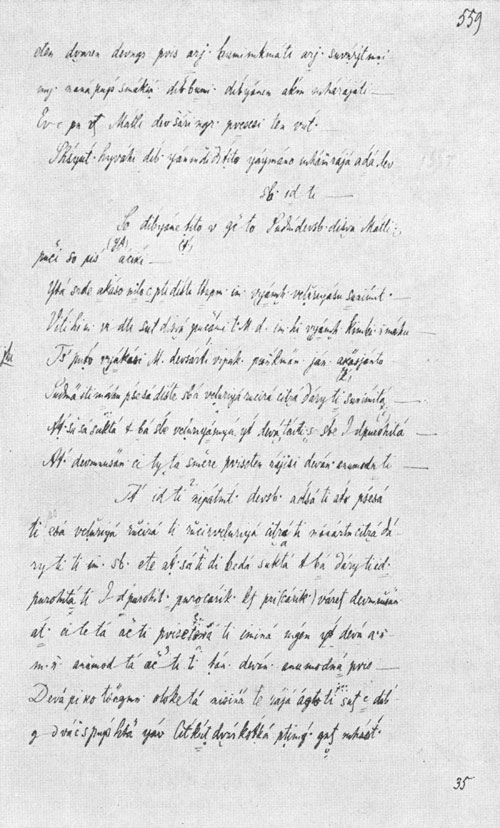
Fig. 1. A page of Trenckner's transcript of the Jataka identical with p. 12619—12715, Vol. VI in Fausbøll's Edition.
According to this system the çloka
sahassayuttaṁ haijavāhiṁ dibbaṁ yānam adhiṭṭhito
yāyamāno mahārājā addā devasabham idan ti
[p. V] is e. g. abbreviated as follows (as far as it is possible to render the handwriting in printed types):
shśyut. hyváhi. dib. yánmdhiṭhito
yáymáno mhárájá adá devsbh. idti.1
Nearly all Trenckner's transcripts are of the size of the present specimen and the result of this system was, that his transcript of the whole Jātaka with its commentary, containing the text of Fausbøll's Edition Vol. Ill—VI, is only 3 small volumes having 2070 pages in all, of which the present is page 559. The transcripts are all so accurate, that it is almost impossible to find an error in a letter, comma, or dot. One is reminded of the words of Māra: satta vassāni Bhagavantaṁ anubandhiṁ padāpadaṁ, otāraṁ nâdhigacchissaṁ Sambuddhassa satīmato!
Trenckner's first plan was to give a critical edition of Abhidhānappadīpikā with an [p. VI] alphabetical index. His Ms. for this edition dates from 1854—55, while his Dhātumañjūsā is from 1858. In the meantime he had transcribed the two first volumes of the Dīgha-Nikāya (ch. I—XVIII, 1856—57), the rest of the same dates from 1867—68. From this first period also dates his transcript of the whole Milinda-pañha (1857—59), of which he finished a clean copy for printing in 1860. From the sixties are his transcripts of Majjhima-Nikāya and Papanca-sūdanī (the last volume of which was finished in 1873), Atthasālinī, Sārasaṅgaha, and Sutta-nipāta, further the whole
Saṁyutta-Nikāya and perhaps also the Aṅguttara-Nikāya; Manoratha-pūraṇī, the commentary on this latter work, which 10 years later was procured by Fausbøll from Ceylon in a modern paper manuscript, he finished in 1885, but unfortunately both his transcript of AN. and Mp. are lost, both having been lent to Dr. Morris in England, and nobody seems to know what has become of these two important manuscripts after the death of Dr. Morris. From the years 1870—79 date his transcripts of the Payogasiddhi, the Jātaka, Paramattha-jotikā, Dhammapadaṭṭhakathā, Parivāra, part of Paramattha-dīpanī, and finally a volume containing Udāna, Itivuttaka, Suttanipāta, Buddhavaṁsa, Cariyā-piṭaka, Thera- & Therī-gāthā (from London-Mss.).
In the year 1880 Trenckner's printed edition of Milindapañha was finished, and during his last 10 years he was engaged on the monumental edition of the Majjhima-Nikāya, of which he did not live to see more than the first half through the press.
[p. VII] All the transcripts of Trenckner are not mere copies of the manuscripts, they are from line to line filled with critical observations and cross-references to parallel passages. In fact, they were not written for publication, but to serve as materials for his great lexicographical and grammatical collections, which he began to arrange from the very first time of his occupation with Pali.
Trenckner's Pāli Dictionary is written on small paper-slips, as will be seen from the specimens figg. 2a and 2b, very often with writing also on the back. It is curious to observe that, when he began to collect the Pali words, he made use of the slips formerly used for his Arabic lexicon. The references begin with Abhidhānapp. (page and verse i Clough's Pah Vocabulary), next follow passages quoted from Trenckner's own transcripts, sometimes having the signature of the palm-leaves, or referring to printed editions, e. g. Mahāvaṁsa ed. Tournour, Vinayapiṭaka, vol. 1—5, Dhammapada (1855), the two first volumes of the Jātaka, etc.
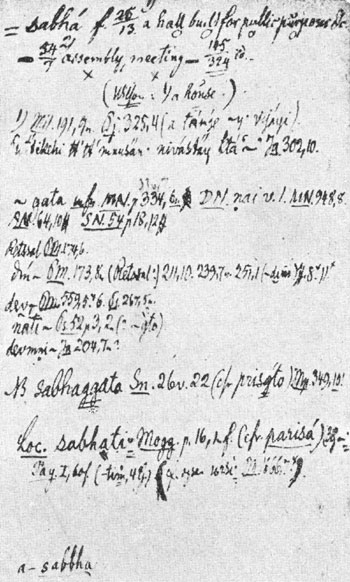
Fig. 2 a. The article sabha. |

Fig. 2 b. The back of 2 a. |
The main stock of these materials contains >only the nouns and indeclinable words in Pali, whilst all the verbal forms are collected in a separate lexicon in the same manner as in Westergaard's Radices linguæ Sanscritæ, but so that the Pāli forms are referred to the different Sanscrit roots, which are placed in the ordinary alphabetical order. Fig. 3 shows the root NAND, that is followed by abhi-°, ā-°, & prati-°, NAM, etc.
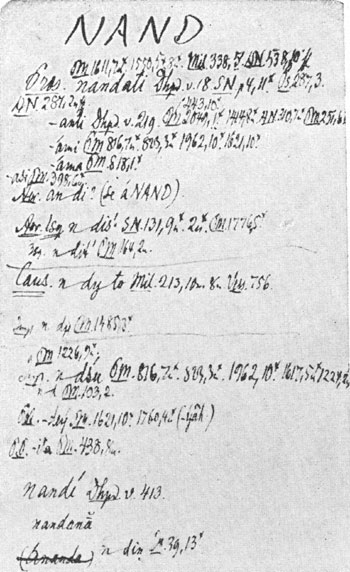
Fig. 3. The Sanskrit root NAND.
Minor portions of the paper-slips contain various observations concerning Pāli grammar, esp. suffixes, syntax, etc. (see fig. 4), miscellaneous quotations from the texts illustrating secular and daily life, chronology, law, names of plants, etc. (proper names and titels of books or their divisions are included among the nouns). With special interest Trenckner devoted himself to the registration of peculiarities in the manuscripts and their writing, miscripts, etc., in Sinhalese and Burmese (see fig. 5, which shows some of his notes on the confounding of letters), all worked out with the usual minute accuracy. Often we find, under words whose spelling varies much in the manuscripts and books, a complete statistical enumeration of the different spellings met with by him.
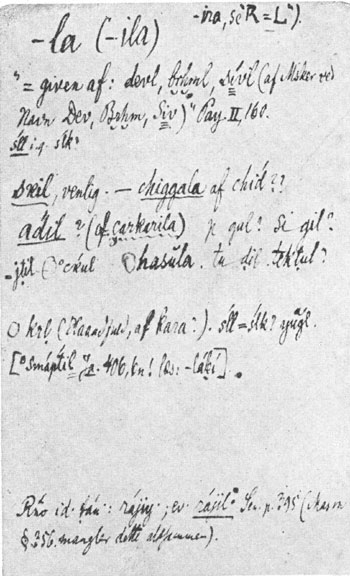
Fig. 4. The Pāli suffix -la. |

Fig. 5. Confounding of letters P, etc. |
In addition to all this Trenckner left two volumes in 4to containing preliminary work for a complete Pāli Grammar (morphology, phonology, and prosody), but this, as well as his lexicon and the edition of Majjhima-Nikāya and its commentary, was unfortunately interrupted by his death in 1891 after more than 35 years' earnest and unswerving exertion. His valuable library was sold to Germany, all his transcripts were presented to our University Library, while the case containing his [p. VIII] lexicon-papers was very generously, by the advice of Fausbøll, given by his executor testamenti to the present writer, who after having put them in order, had them deposited in the Library with the other manuscripts.
Trenckner is now only a name (nāmamattaṁ), but this name deserves to be deeply inscribed in the history of Pali philology, and his work ought not to be forgotten or lost. His whole life bore the impress of resignation, industry, and charity He led a quiet and solitary life, and he never travelled outside his own country and rarely out of town; his extraordinary frugality enabled him to save up a small capital, which he left by will for the benefit of the Orphans' Asylum, where he had worked during 30 years, and where many persons have remembered his benevolence. No monument adorns his grave, but on the stele which ought to have been erected there we think these words might have been fittingly engraved:
Dines Andersen.
1 Note that aspirate consonants are not in this system expressed by th, bh, etc., but only by one letter, a slight variation of t, b, etc., and that' denotes vowel-length as well as double consonants; the anusvāra is always marked by (.), while a nasal before another consonant is expressed by (•).
A Critical Pāli Dictionary Online is maintained by the Data Center for the Humanities at the University of Cologne in cooperation with the Pali Text Society. The project was originally carried out by the Department of Cross-Cultural and Regional Studies (ToRS) at the University of Copenhagen. It has been set up again in 2016 by Marcello Perathoner (Cologne Center for eHumanities) • Contact: cpd-contact@uni-koeln.de • Data Privacy Statement (German)

